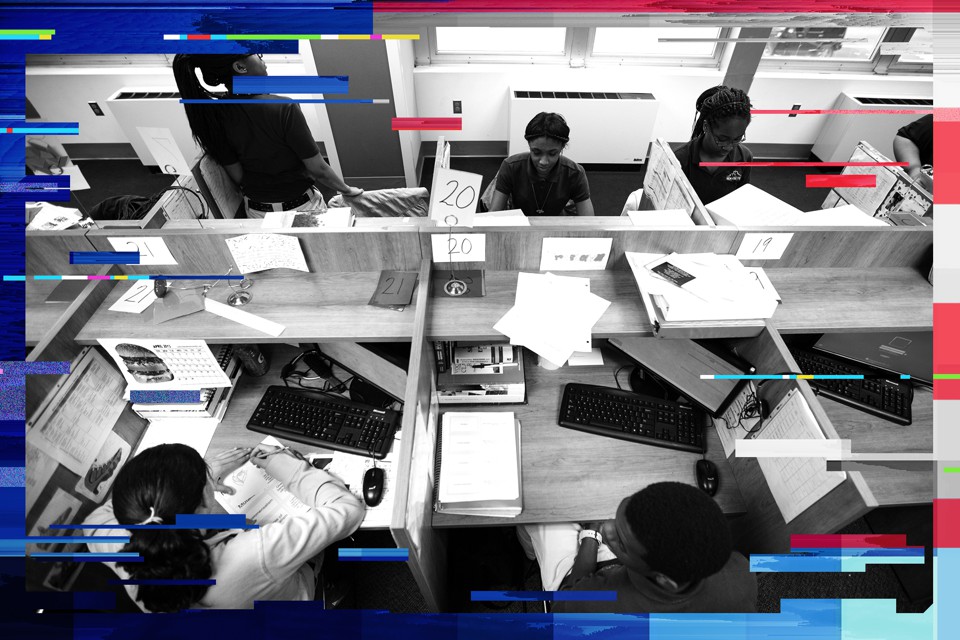
American democracy is in crisis. Part of that crisis has to do with technology. But there’s another, often overlooked, factor at play.
I’m a professor, so I think that fixing America starts with education. We can help improve our democratic processes by using technology to improve schools. I don’t mean that we should put iPads into every school, or give every child a laptop. I mean something more fundamental: We should use technology to make sure every public school in America has all of the books, supplies, and learning materials that they need.
A shocking number of public schools don’t have these basic tools. Without the basics, we can’t properly educate the next generation of informed citizens.
Technology is the only way to keep track of how many students are in each school, and what books and supplies each teacher needs. A few years ago, I did an investigative project in which I looked at whether Philadelphia schools had enough books for their students. They didn’t. The same people write the books and write the standardized tests; my not-so-radical suggestion was that the students needed the books to prepare for the tests. The average Philly school had only 27 percent of the books they would need to teach the students in the building. Since then, Philadelphia has allocated $36 million for “new textbooks and curriculum materials,” provided a new computer to each pre-K-12 teacher, and allocated $7.8 million as a one-time investment for “additional supplies and educational materials for every school.” It’s a step in the right direction.
I know that books aren’t the whole story (I teach computational journalism). Students also need spacious, well-lit classrooms with working internet connections. They need safe schools with bathrooms that work and are cleaned regularly. They need unleaded water in school buildings with roofs that don’t leak and grow mold. In too many cases, these basic needs are not met in Philadelphia’s public schools, nor in other major American cities.
A few more items at the top of my let’s-improve-democracy wish list: We should pay public school teachers more, and hire more of them so class sizes are smaller. Teachers aren’t paid enough, and yet they are so dedicated that they spend their own money on supplies. (Thank you, teachers.)
We need to fix the copiers and printers in every school and keep them stocked with plenty of paper. If you are a school district that doesn’t buy books and workbooks, and instead you make teachers teach using random stuff they find on the Internet, then you don’t even provide a copier and printer that work—well, you’ve just created major obstacles to your students becoming educated citizens. If the copier doesn’t work, the teacher is stranded. Broken technology hurts democracy.
I truly wish there were a single technological solution that would fix every problem in every classroom. Then, I could wave a magic wand and declare, “Make it so!” But public school is a complex system that doesn’t really work without humans in the loop.
We’ve certainly tried replacing teachers with computer-based training. It has not gone well. Have you attempted any of the online learning modules that kids get assigned? I have. Most are deathly boring. Or there are the modules that claim to be “fun,” where the creators package up a mundane, repetitive arithmetic task as some kind of animal flying around the screen or navigating some kind of ridiculous maze. Kids recognize this. This is the kind of “fun” that your mom means when she says it’s going to be fun to learn how to do laundry, or to clean the smelly, rotten leaves out of the gutters.
We need technology to run our schools. Not glamorous cutting-edge technology, but workhorse technology: databases, and staff to enter the data into the databases, and database administrators to keep everything running and do the load-balancing at the beginning and end of the semester when hundreds of schools are trying to enter in their updated inventory data simultaneously. We need more accurate budgeting that factors in everything a school needs, from pencils to laptops to tater tots. We could use artificial intelligence if that makes it seem more exciting. To investigate the book situation (and offer a solution) in Philadelphia, I built A.I. software. It’s open source, and it’s available online, for free. School districts have not yet come knocking on my door, begging me to implement it so they can update their budgeting and inventory management processes—but hope springs eternal.
Thomas Jefferson once wrote: “Educate and inform the whole mass of the people… they are the only sure reliance for the preservation of our liberty.” I believe this. And I believe that technology can help us make a better world. However, I don’t believe that we need radically new, different technology to fix America’s public schools. We can start by fixing and funding what we already have.
[“source-ndtv”]
 Techosta Where Tech Starts From
Techosta Where Tech Starts From